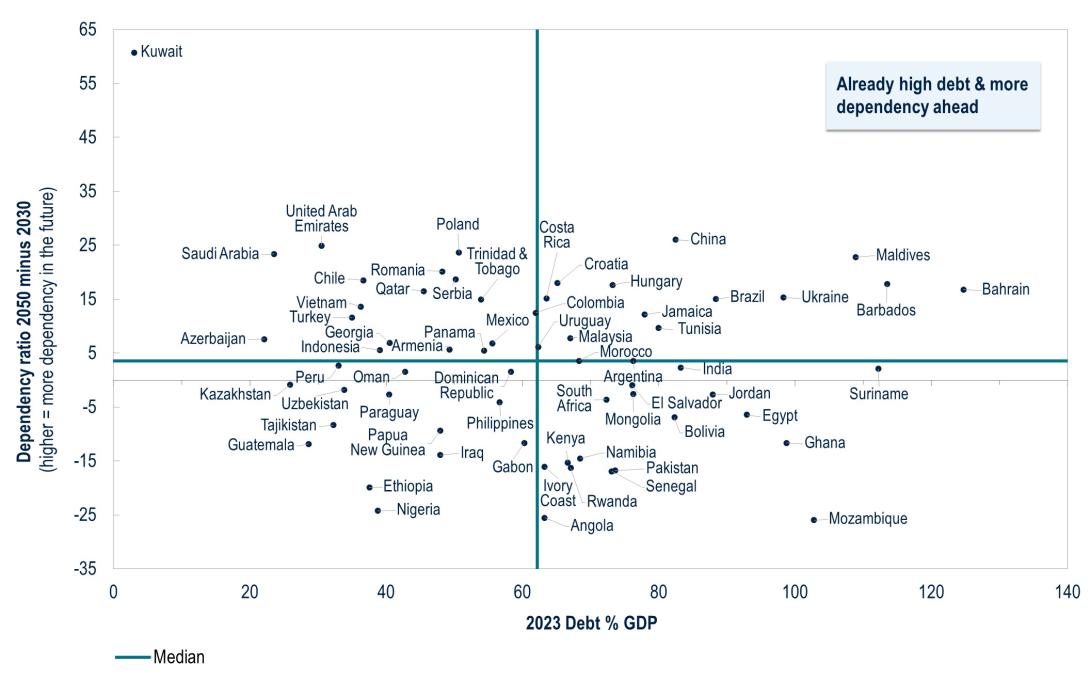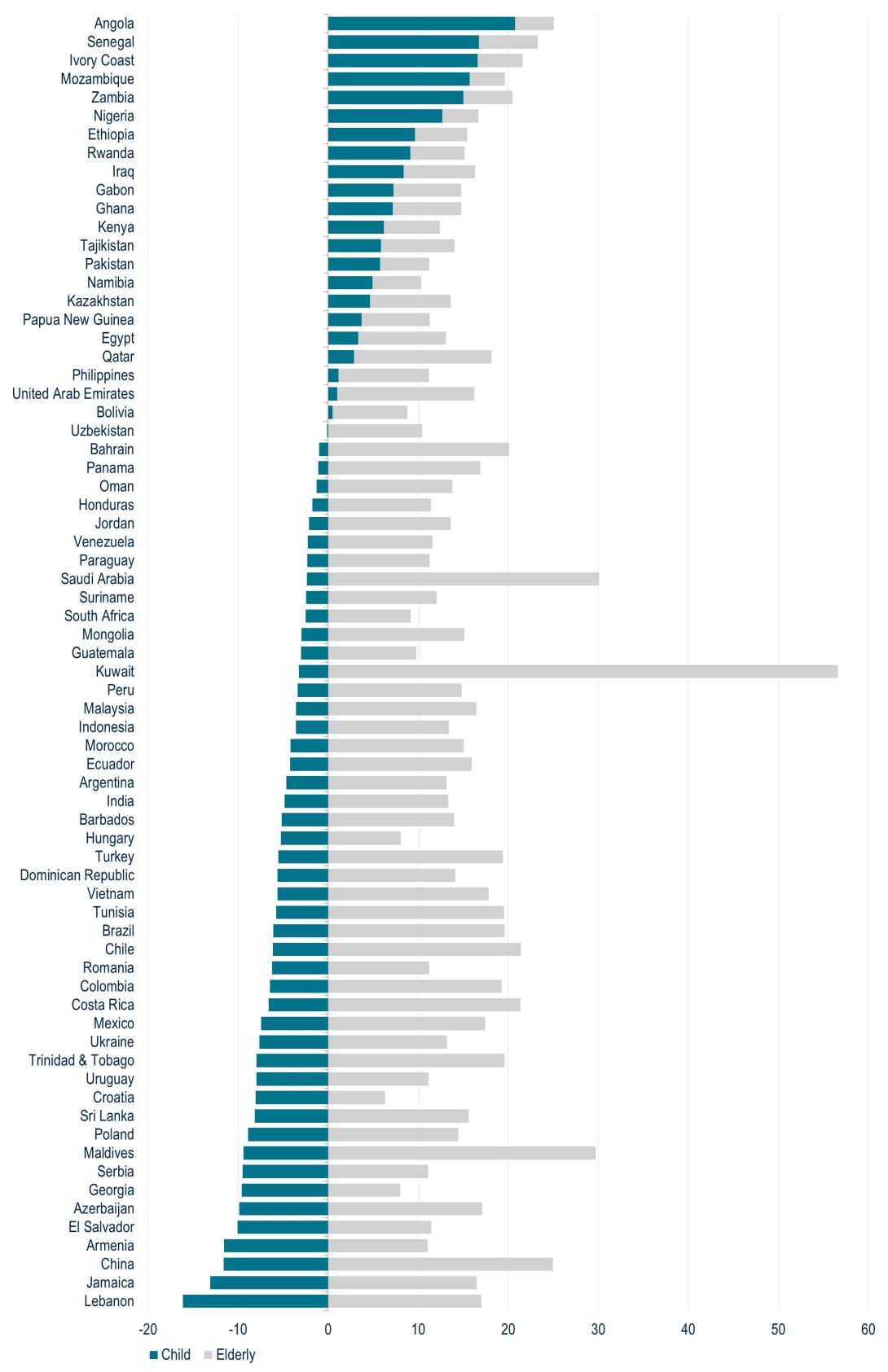Greying and Greening Across Emerging Markets

The demographic story of the past few decades has been one of “greying” across developed market (DM) countries as increasing longevity and declining fertility lead to societal aging. However, far less attention has been paid to the looming demographic transition across emerging market (EM) countries, where populations are also set to begin aging rapidly. While “greying” reflects positive developments in human progress (i.e., people living longer and healthier lives), it also presents new policy challenges as smaller labor forces will be forced to support larger dependent populations. With the share of the EM population aged 65 and over expected to soar over the next two decades, we examine which EMs face the strongest demographic pressure as part of our ongoing research into the global shift in labor dynamics.
While China captured headlines last year as deaths outnumbered births there for the first time in six decades, far less attention was paid to the “greying” of other EM countries where the share of the population aged 65 and over is projected to nearly double over the next two decades (Figure 1).
Figure 1: DMs have Been Greying More Quickly, but the EM Transition Has Arrived (%)

Source: World Bank as of May 2023. Note: DM average is calculated as the mean of U.S., Europe, Japan, Australia, and New Zealand. EM average is calculated as the mean of the 70 countries in JP Morgan’s Emerging Markets Global Diversified Index.
Demographic Pressures, Fiscal Trade Offs
The “traditional” DM trajectory has been one of rising incomes accompanied by falling fertility and increased longevity. If fertility rates dip below the replacement level required for population growth, both the size of the population and of supply of workers will shrink (absent migration). Working age citizens are much more likely to participate in the labor force and pay taxes that fund social services. A smaller labor force implies lower tax revenue and stronger pressures on pension systems, healthcare spending, and ultimately government budgets. Without an increase in productivity, a smaller labor force cannot sustain the same level of economic growth. At the same time, this smaller labor force will be responsible for supporting a larger dependent population (children and elderly). All these dynamics add up to stronger fiscal pressure as social spending must increase amidst falling government revenue.
Although EMs will remain “younger” in relative terms than DMs, they are set to experience rapid societal aging from much lower levels of wealth and financial resources. To investigate where these risks are most pronounced, we analyze EM countries’ dependency ratios.1
We conduct our analysis on the credits included in the JP Morgan Emerging Markets Global Diversified Index, calculating the change in dependency ratios from 2023 to 2050 to understand how these metrics are projected to shift over the next two decades. A positive change means that the number of dependents in a country should increase relative to the size of the working age population.
Next, we plot these changes in dependency ratios against debt as a share of GDP in 2023 (Figure 2).
Figure 2: Demographics and Debt across EMs

Source: PGIM Fixed Income, Macrobond, IMF, UN as of May 2023.
Countries in the top right quadrant have already high debt burdens and are projected to have growth in dependency ahead, setting them up for an increasingly precarious fiscal situation. China is in this quadrant. Countries in the top left quadrant face similar demographic pressures, but they are starting from much more favorable debt profiles, thus they have larger buffers to fund social spending.
Kuwait stands out as a significant outlier but is not expected to face major financing difficulties in the future due to its small population and forward-looking fiscal stance that allows for an accumulation of assets in the country’s sovereign wealth fund. Furthermore, more immigration could lower the dependency ratio.
More Older Adults than Children
While informative, Figure 2 does not distinguish if an increase in the dependency ratio is because more children are being born (“greening”) or more adults are aging (“greying”). So, next we decompose the change in dependency ratios to understand if the young or old are driving the shift.
Figure 3: Greying versus Greening (% 2050 Working Age Population)

Source: PGIM Fixed Income, UN as of May 2023.
In Figure 3 the green bars represent the projected change in the child population from 2023 to 2050 as a percentage of the 2050 working age population. The grey bars represent the same for the 65+ population. All EMs will be “greying” over the next two decades, as all have positive grey bars. However, only some EMs will still be “greening.” Uzbekistan and all the countries that fall below it are projected to see contractions in their child populations.
From the chart we can see that a massive “greying” rather than “greening” is driving the growth in Kuwait’s dependency ratio. In fact, Kuwait’s child population is set to shrink over the next two decades, further pressuring its demographic profile.
There are few countries in our sample where the child population is projected to grow. These “greening” EMs are heavily concentrated in Sub-Saharan Africa, with a few Central and South Asian additions. However, even within this small subset of “greening” countries, only about half have projected child population growth large enough to outweigh their “greying” population (i.e., Angola through Iraq).
The Path Forward
Demographic dynamics pose significant fiscal challenges for both “greying” and “greening” countries and this backdrop influences investment positioning and the types of risk assumed across portfolios. For the “greying” countries, especially for those countries with both high debt and high dependency rates, fiscal prudence, together with reforms, is warranted to ensure the sustainability of pension and health systems and to reassure long-term investors. For the “greening” countries, challenges are different: taking advantage of a rapidly growing young population requires investment in education and training in order to ensure the economic inclusion of young people, boost productivity, and achieve balanced growth. For countries with an already high debt-to-GDP ratio, though, fiscal space is limited and, unfortunately, fiscal allocations for education are often the first to be cut in pursuit of fiscal adjustment. For these credits, we believe that the engagement of official creditors and International Financial Institutions is crucial for both adopting the right policies and inducing investment to finance their growth.
1 Defined by the United Nations as = {[The number of children (0–14 years old) & older persons (65 years +)]/The number of persons of working age (15–64 years old)} * 100. Population data are those of medium variant.
Read More From PGIM Fixed Income
The comments, opinions, and estimates contained herein are based on and/or derived from publicly available information from sources that PGIM Fixed Income believes to be reliable. We do not guarantee the accuracy of such sources or information. This outlook, which is for informational purposes only, sets forth our views as of this date. The underlying assumptions and our views are subject to change. Past performance is not a guarantee or a reliable indicator of future results.
Source(s) of data (unless otherwise noted): PGIM Fixed Income, as of 6/21/2023.
For Professional Investors only. Past performance is not a guarantee or a reliable indicator of future results and an investment could lose value. All investments involve risk, including the possible loss of capital.
PGIM Fixed Income operates primarily through PGIM, Inc., a registered investment adviser under the U.S. Investment Advisers Act of 1940, as amended, and a Prudential Financial, Inc. (“PFI”) company. Registration as a registered investment adviser does not imply a certain level or skill or training. PGIM Fixed Income is headquartered in Newark, New Jersey and also includes the following businesses globally: (i) the public fixed income unit within PGIM Limited, located in London; (ii) PGIM Netherlands B.V., located in Amsterdam; (iii) PGIM Japan Co., Ltd. (“PGIM Japan”), located in Tokyo; (iv) the public fixed income unit within PGIM (Hong Kong) Ltd. located in Hong Kong; and (v) the public fixed income unit within PGIM (Singapore) Pte. Ltd., located in Singapore (“PGIM Singapore”). PFI of the United States is not affiliated in any manner with Prudential plc, incorporated in the United Kingdom or with Prudential Assurance Company, a subsidiary of M&G plc, incorporated in the United Kingdom. Prudential, PGIM, their respective logos, and the Rock symbol are service marks of PFI and its related entities, registered in many jurisdictions worldwide.
These materials are for informational or educational purposes only. The information is not intended as investment advice and is not a recommendation about managing or investing assets. In providing these materials, PGIM is not acting as your fiduciary. PGIM Fixed Income as a general matter provides services to qualified institutions, financial intermediaries and institutional investors. Investors seeking information regarding their particular investment needs should contact their own financial professional.
These materials represent the views and opinions of the author(s) regarding the economic conditions, asset classes, securities, issuers or financial instruments referenced herein. Distribution of this information to any person other than the person to whom it was originally delivered and to such person’s advisers is unauthorized, and any reproduction of these materials, in whole or in part, or the divulgence of any of the contents hereof, without prior consent of PGIM Fixed Income is prohibited. Certain information contained herein has been obtained from sources that PGIM Fixed Income believes to be reliable as of the date presented; however, PGIM Fixed Income cannot guarantee the accuracy of such information, assure its completeness, or warrant such information will not be changed. The information contained herein is current as of the date of issuance (or such earlier date as referenced herein) and is subject to change without notice. PGIM Fixed Income has no obligation to update any or all of such information; nor do we make any express or implied warranties or representations as to the completeness or accuracy.
Any forecasts, estimates and certain information contained herein are based upon proprietary research and should not be interpreted as investment advice, as an offer or solicitation, nor as the purchase or sale of any financial instrument. Forecasts and estimates have certain inherent limitations, and unlike an actual performance record, do not reflect actual trading, liquidity constraints, fee. These materials are not intended as an offer or solicitation with respect to the purchase or sale of any security or other financial instrument or any investment management services and should not be used as the basis for any investment decision. PGIM Fixed Income and its affiliates may make investment decisions that are inconsistent with the recommendations or views expressed herein, including for proprietary accounts of PGIM Fixed Income or its affiliates.
Investing in the bond market is subject to risks, including market, interest rate, issuer, credit, inflation risk, and liquidity risk. The value of most bonds and bond strategies are impacted by changes in interest rates. Bonds and bond strategies with longer durations tend to be more sensitive and volatile than those with shorter durations; bond prices generally fall as interest rates rise, and low interest rate environments increase this risk. Reductions in bond counterparty capacity may contribute to decreased market liquidity and increased price volatility. Bond investments may be worth more or less than the original cost when redeemed. Mortgage- and asset-backed securities may be sensitive to changes in interest rates, subject to early repayment risk, and while generally supported by a government, government agency or private guarantor, there is no assurance that the guarantor will meet its obligations. High yield, lower-rated securities involve greater risk than higher-rated securities; portfolios that invest in them may be subject to greater levels of credit and liquidity risk than portfolios that do not. Investing in foreign-denominated and/or -domiciled securities may involve heightened risk due to currency fluctuations, and economic and political risks, which may be enhanced in emerging markets. Currency rates may fluctuate significantly over short periods of time and may reduce the returns of a portfolio. Commodities contain heightened risk, including market, political, regulatory and natural conditions, and may not be suitable for all investors. Diversification does not ensure against loss.
In the United Kingdom, information is issued by PGIM Limited with registered office: Grand Buildings, 1-3 Strand, Trafalgar Square, London, WC2N 5HR. PGIM Limited is authorised and regulated by the Financial Conduct Authority (“FCA”) of the United Kingdom (Firm Reference Number 193418). In the European Economic Area (“EEA”), information is issued by PGIM Netherlands B.V., an entity authorised by the Autoriteit Financiële Markten (“AFM”) in the Netherlands and operating on the basis of a European passport. In certain EEA countries, information is, where permitted, presented by PGIM Limited in reliance of provisions, exemptions or licenses available to PGIM Limited under temporary permission arrangements following the exit of the United Kingdom from the European Union. These materials are issued by PGIM Limited and/or PGIM Netherlands B.V. to persons who are professional clients as defined under the rules of the FCA and/or to persons who are professional clients as defined in the relevant local implementation of Directive 2014/65/EU (MiFID II). In certain countries in Asia-Pacific, information is presented by PGIM (Singapore) Pte. Ltd., a Singapore investment manager registered with and licensed by the Monetary Authority of Singapore. In Japan, information is presented by PGIM Japan Co. Ltd., registered investment adviser with the Japanese Financial Services Agency. In South Korea, information is presented by PGIM, Inc., which is licensed to provide discretionary investment management services directly to South Korean investors. In Hong Kong, information is provided by PGIM (Hong Kong) Limited, a regulated entity with the Securities & Futures Commission in Hong Kong to professional investors as defined in Section 1 of Part 1 of Schedule 1 (paragraph (a) to (i) of the Securities and Futures Ordinance (Cap.571). In Australia, this information is presented by PGIM (Australia) Pty Ltd (“PGIM Australia”) for the general information of its “wholesale” customers (as defined in the Corporations Act 2001). PGIM Australia is a representative of PGIM Limited, which is exempt from the requirement to hold an Australian Financial Services License under the Australian Corporations Act 2001 in respect of financial services. PGIM Limited is exempt by virtue of its regulation by the FCA (Reg: 193418) under the laws of the United Kingdom and the application of ASIC Class Order 03/1099. The laws of the United Kingdom differ from Australian laws. In Canada, pursuant to the international adviser registration exemption in National Instrument 31-103, PGIM, Inc. is informing you that: (1) PGIM, Inc. is not registered in Canada and is advising you in reliance upon an exemption from the adviser registration requirement under National Instrument 31-103; (2) PGIM, Inc.’s jurisdiction of residence is New Jersey, U.S.A.; (3) there may be difficulty enforcing legal rights against PGIM, Inc. because it is resident outside of Canada and all or substantially all of its assets may be situated outside of Canada; and (4) the name and address of the agent for service of process of PGIM, Inc. in the applicable Provinces of Canada are as follows: in Québec: Borden Ladner Gervais LLP, 1000 de La Gauchetière Street West, Suite 900 Montréal, QC H3B 5H4; in British Columbia: Borden Ladner Gervais LLP, 1200 Waterfront Centre, 200 Burrard Street, Vancouver, BC V7X 1T2; in Ontario: Borden Ladner Gervais LLP, 22 Adelaide Street West, Suite 3400, Toronto, ON M5H 4E3; in Nova Scotia: Cox & Palmer, Q.C., 1100 Purdy’s Wharf Tower One, 1959 Upper Water Street, P.O. Box 2380 - Stn Central RPO, Halifax, NS B3J 3E5; in Alberta: Borden Ladner Gervais LLP, 530 Third Avenue S.W., Calgary, AB T2P R3.
© 2023 PFI and its related entities.
2023-4467
Sign Up Now for Full Access to Articles and Podcasts!
Unlock full access to our vast content library by registering as an institutional investor .
Create an accountAlready have an account ? Sign in
